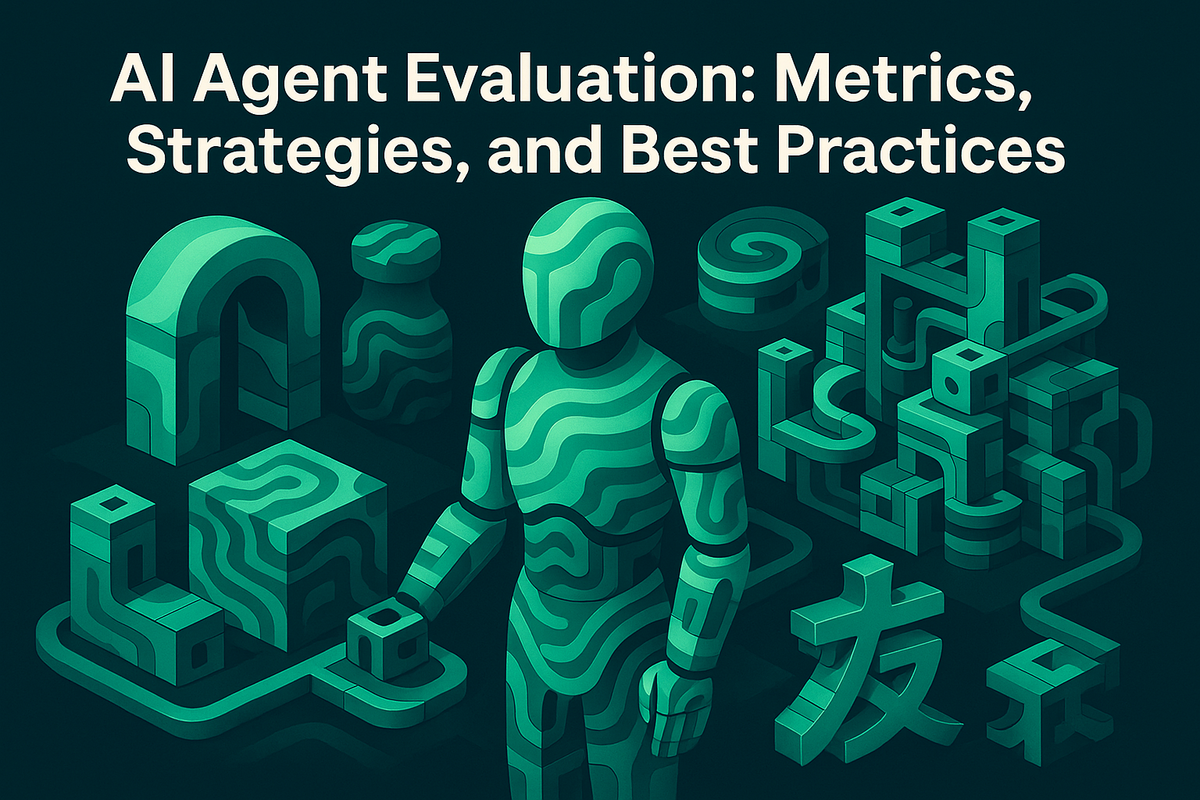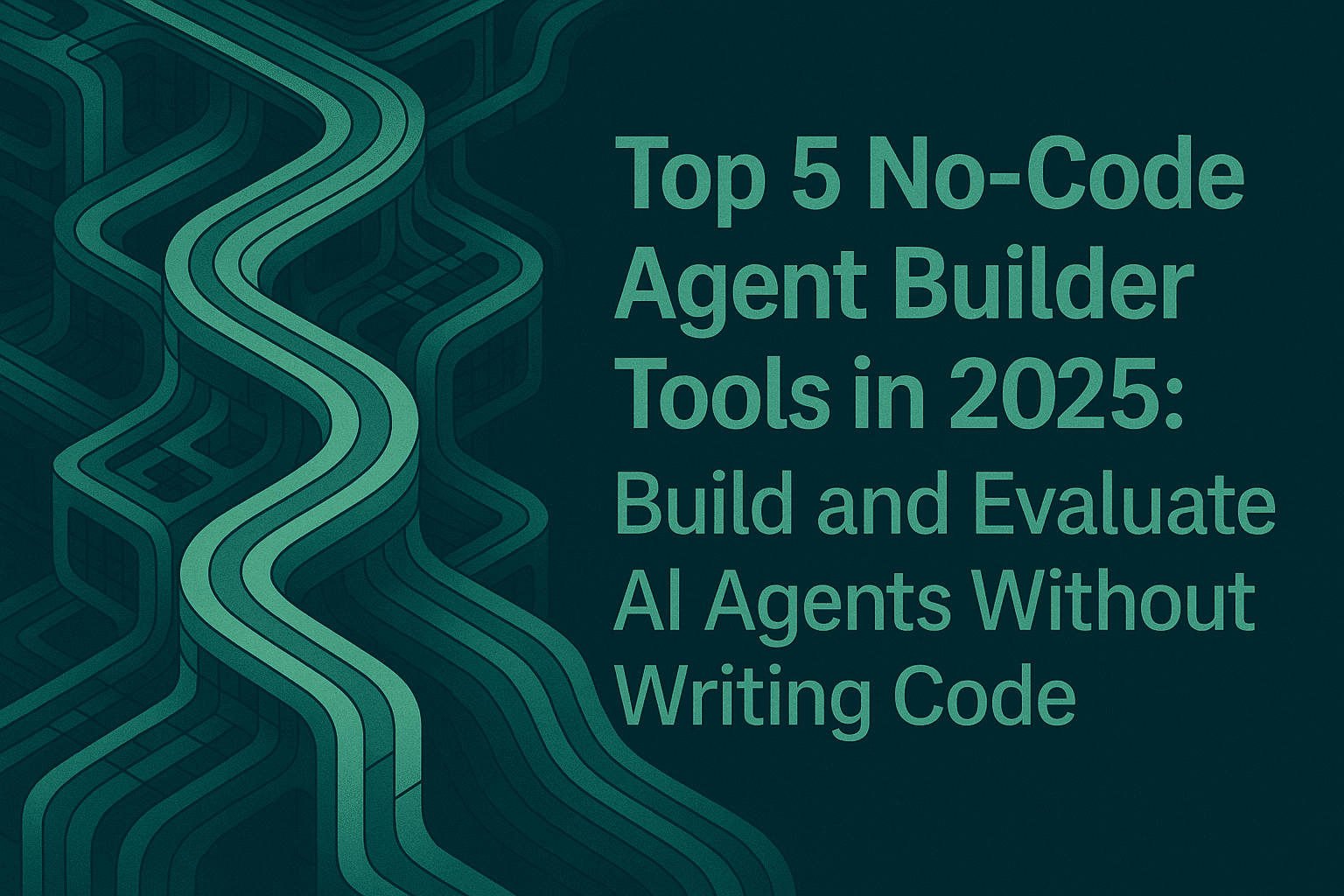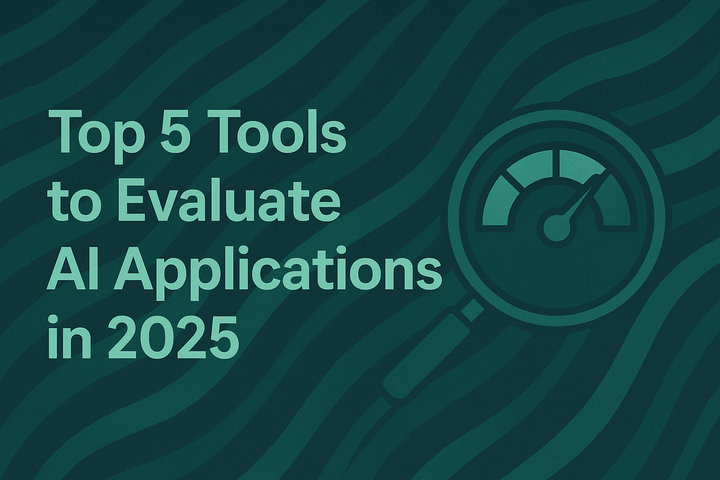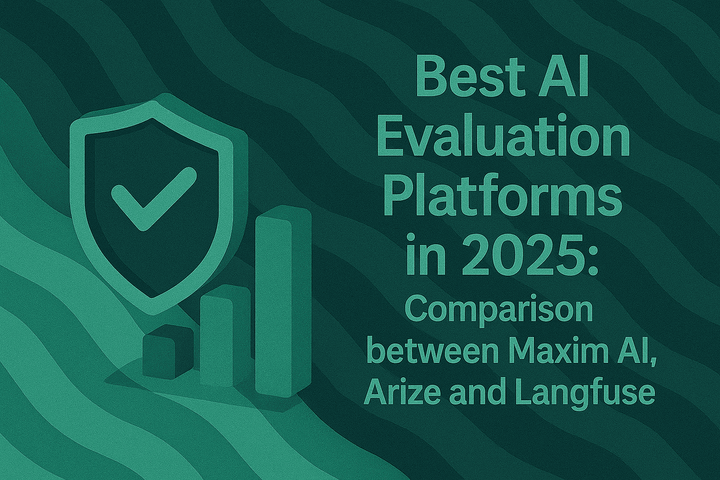AI Agent Evaluation: Metrics, Strategies, and Best Practices

TL;DR
AI agent evaluation is critical for building reliable, production-ready autonomous systems. As organizations deploy AI agents for customer service, coding assistance, and complex decision-making tasks, systematic evaluation becomes essential to ensure these agents meet performance standards, maintain alignment with business goals, and operate safely at scale.
This comprehensive guide covers:
- Technical foundations of AI agent evaluation and why it matters for autonomous systems
- Key metrics across multiple system layers—from model performance to application-level outcomes
- Evaluation strategies including automated testing, human-in-the-loop review, LLM-as-judge, and simulation
- Best practices for implementing robust evaluation frameworks with continuous feedback loops
- Actionable frameworks for measuring and improving AI agent quality throughout the development lifecycle
Whether building customer support agents or complex multi-agent systems, this guide provides practical approaches to ensure your AI agents deliver consistent value in production.
Introduction
The deployment of AI agents has accelerated dramatically across industries. The AI agent market reached $5.4 billion in 2024 and is projected to grow at 45.8% annually through 2030, reflecting the rapid adoption of autonomous systems capable of reasoning, planning, and acting with minimal human intervention.
Unlike traditional AI models that simply generate outputs, AI agents operate autonomously within complex workflows. They interact with external tools, make sequential decisions, and adapt their behavior based on environmental feedback. This autonomy introduces new challenges:
- Agents can deviate from expected behavior in subtle but impactful ways
- Errors in production can be costly and damage user trust
- Alignment with business objectives becomes harder to validate
- Multi-step reasoning processes create more failure points
- Tool interactions and external dependencies add complexity
AI agent evaluation addresses these challenges by providing systematic methods to measure agent performance, identify failure modes, and validate behavior before production deployment. Evaluating LLM agents is more complex than evaluating traditional language models because agents must be assessed not just on output quality, but on their reasoning processes, decision-making patterns, and ability to complete multi-step tasks reliably.
The stakes are high. Agents deployed without rigorous evaluation can generate incorrect responses, escalate simple issues unnecessarily, or consume excessive computational resources. Conversely, well-evaluated agents deliver consistent experiences, reduce operational costs, and maintain alignment with organizational standards. This makes evaluation not just a technical requirement, but a business imperative for teams building production AI systems.
What is AI Agent Evaluation?
AI agent evaluation is the systematic process of measuring and validating the performance, reliability, and alignment of autonomous AI systems against defined criteria. Unlike evaluating static machine learning models, agent evaluation assesses dynamic behavior across multi-step interactions, tool usage, reasoning chains, and task completion.
At its core, agent evaluation examines whether an agent can consistently achieve its intended objectives while maintaining safety, efficiency, and alignment with organizational goals. This involves analyzing not just final outputs, but the complete trajectory of actions, decisions, and interactions the agent takes to reach those outputs.
Why Evaluations Matter
Maintaining Reliability
Production AI agents must deliver consistent performance across diverse scenarios. Evaluation frameworks provide:
- Baseline performance levels for comparison over time
- Detection of degradation before it impacts users
- Visibility into whether agents meet reliability standards
- Early warning of behavioral drift from expected patterns
Without systematic evaluation, teams lack insight into agent consistency and can't identify quality issues until users report problems.
Catching Bugs and Misalignment
Autonomous agents can develop unexpected behaviors that aren't immediately obvious in casual testing. Evaluation uncovers:
- Edge cases where agents make incorrect tool selections
- Hallucinated information that appears plausible but is incorrect
- Deviations from established guidelines and policies
- Security vulnerabilities like prompt injection susceptibility
Agent development is driven by benchmarks, and current evaluation practices play a crucial role in identifying these issues before deployment.
Enabling Iteration for Better Outputs
Evaluation provides the quantitative feedback necessary for systematic improvement. Teams can:
- Compare prompt variations based on measurable outcomes
- Evaluate different model choices objectively
- Test architectural decisions with data rather than intuition
- Accelerate development cycles by reducing guesswork
This data-driven approach transforms optimization from an art into a science.
Measuring Business Goal Alignment
Technical metrics alone don't guarantee business value. Evaluation frameworks must assess:
- Customer support agents: resolution rate, escalation frequency, satisfaction scores
- Coding assistants: code correctness, test coverage, build success rates
- Sales agents: conversion rates, lead qualification accuracy, engagement quality
- Healthcare assistants: diagnostic accuracy, guideline compliance, patient safety
Maxim's evaluation framework allows teams to quantify improvements or regressions and deploy with confidence.
Comparing and Choosing Better Approaches
When evaluating different agent architectures, systematic evaluation provides:
- Objective criteria for decision-making
- Quantifiable trade-offs between accuracy, latency, and cost
- Performance comparisons across prompt strategies
- Model selection guidance based on real-world metrics
This eliminates bias and guesswork from critical technical decisions.
Resource Management
AI agents consume significant computational resources through LLM calls, tool interactions, and retrieval operations. Evaluation helps:
- Identify inefficiencies in reasoning chains
- Optimize token usage across interactions
- Reduce operational costs without sacrificing quality
- Scale systems efficiently as usage grows
This becomes critical at scale where small inefficiencies multiply across thousands of daily interactions.
Key Metrics for Evaluating AI Agents
AI agent evaluation requires metrics across multiple system layers. Each layer contributes to overall agent performance and must be measured independently to identify specific optimization opportunities.
Model and LLM Layer Metrics
Accuracy
Measures how often the agent's outputs match expected results:
- Classification tasks: precision, recall, and F1-score
- Generation tasks: factual correctness and ground truth alignment
- Domain-specific accuracy for specialized applications
Statistical evaluators like F1-score, precision, and recall provide quantitative measures of classification performance.
Latency
Response time directly impacts user experience:
- Time from query submission to final response
- Model inference duration
- Tool call execution time
- Retrieval operation latency
- Network and API overhead
Production systems must maintain latency within acceptable thresholds even under load.
Cost
Each agent interaction incurs costs:
- Token usage per interaction
- Number of LLM API calls
- Infrastructure and compute expenses
- Storage costs for context and logs
Bifrost's semantic caching can significantly reduce costs by intelligently caching responses based on semantic similarity.
Robustness
Measures agent resilience to challenging inputs:
- Performance across diverse phrasings and formulations
- Handling of edge cases and unexpected scenarios
- Resistance to adversarial prompts and injection attacks
- Graceful degradation under difficult conditions
Toxicity detection helps ensure agents remain safe under challenging inputs.
Orchestration Layer Metrics
Agent Trajectory Quality
Evaluates the sequence of actions and decisions:
- Logical reasoning paths through multi-step tasks
- Appropriate intermediate decisions
- Efficiency of chosen approach
- Avoidance of circular reasoning or loops
Agent trajectory evaluators assess whether agents follow sound reasoning patterns.
Tool Selection Accuracy
Measures whether agents correctly identify and invoke relevant tools:
- Correct tool chosen for given tasks
- Appropriate parameters passed to functions
- Efficient use of available capabilities
- Avoidance of unnecessary tool calls
Tool selection evaluators and tool call accuracy metrics validate appropriate function usage.
Step Completion
Tracks whether agents successfully execute required steps:
- All necessary steps completed in workflows
- Steps executed in correct order when required
- No critical steps skipped or forgotten
- Proper handling of conditional branches
Step completion evaluators can enforce strict ordering or use unordered matching for flexible workflows.
Step Utility
Assesses whether each agent action contributes meaningfully:
- Actions advance task toward completion
- No redundant or unnecessary operations
- Efficient reasoning without wasted steps
- Productive use of computational resources
Step utility metrics identify inefficient reasoning patterns.
Vector Database and Knowledge Base Layer Metrics
Context Relevance
Measures whether retrieved information relates meaningfully to queries:
- Retrieved documents address user questions
- Information is topically aligned with queries
- Irrelevant content is filtered out
- Search quality matches user intent
Context relevance evaluators ensure retrieval systems surface appropriate documents.
Context Precision
Assesses whether retrieved chunks contain necessary information:
- High signal-to-noise ratio in retrieved content
- Relevant information concentrated in results
- Minimal extraneous content
- Efficient use of context window
Context precision metrics measure information density in retrievals.
Context Recall
Evaluates whether all relevant information was retrieved:
- No important context missed during retrieval
- Complete information coverage for queries
- Comprehensive search results
- Adequate depth of retrieved knowledge
Context recall identifies cases where critical context was overlooked.
Faithfulness
Measures whether agent responses are grounded in retrieved context:
- Claims supported by provided sources
- No hallucinated information beyond context
- Accurate representation of source material
- Clear distinction between retrieved facts and inferences
Faithfulness evaluators validate agents don't fabricate information.
Prompt and System Prompt Layer Metrics
Clarity
Evaluates whether agent responses are clear and understandable:
- Plain language without unnecessary jargon
- Well-structured explanations
- Logical flow of information
- Appropriate detail level for audience
Clarity metrics assess readability and comprehension.
Conciseness
Measures whether responses are appropriately brief:
- No unnecessary verbosity
- Complete information without excess
- Efficient communication
- Respect for user time and attention
Conciseness evaluators identify unnecessarily verbose outputs.
Consistency
Assesses whether agents provide consistent responses:
- Similar queries receive similar answers
- No contradictions across interactions
- Stable behavior over time
- Predictable agent personality and tone
Consistency metrics detect unwanted variation in behavior.
PII Detection
Validates that agents don't expose sensitive information:
- No personally identifiable information leaked
- Compliance with privacy regulations
- Protection of user data
- Appropriate handling of confidential content
PII detection evaluators help maintain compliance standards.
Application and Integration Layer Metrics
Task Success Rate
The most fundamental metric—whether agents complete assigned tasks:
- Binary assessment: task completed or failed
- Graded evaluation: partial completion measured
- Multi-step task tracking
- Success rate trends over time
Task success evaluators provide completion assessments.
User Satisfaction
Measures end-user perception of agent performance:
- Explicit feedback through ratings and surveys
- Implicit signals like conversation continuation
- Resolution satisfaction
- Recommendation likelihood
Maxim's user feedback integration enables collection and analysis of production feedback.
Adaptability
Assesses how well agents adjust to new scenarios:
- Generalization beyond training distributions
- Performance on novel tasks
- Learning from interaction patterns
- Flexibility across domains and contexts
Adaptable agents maintain quality as requirements evolve.
Semantic Similarity
Compares agent outputs to reference responses using embeddings:
- Meaning-based evaluation beyond exact matching
- Tolerance for equivalent phrasings
- Conceptual alignment measurement
- Embedding space distance metrics
Semantic similarity and various embedding distance metrics enable nuanced output comparison.
AI Agent Evaluation Strategies
Effective evaluation combines multiple strategies, each addressing different aspects of agent quality and reliability.
Automated Evaluation
Automated evaluation provides scalable, consistent assessment across large test suites. This approach uses programmatic checks, statistical measures, and AI-based evaluators to validate agent behavior without manual review.
Statistical Evaluators
Traditional NLP metrics quantify output similarity:
- BLEU: measures n-gram overlap with references
- ROUGE variants: assess summarization quality
- Embedding distances: capture semantic similarity
- Works well for tasks with clear expected outputs
Programmatic Evaluators
Rule-based checks validate specific properties:
- Format compliance: valid JSON, XML structure
- Data validation: email formats, URL validity, phone numbers
- Constraint satisfaction: date validation, range checks
- Deterministic and fast execution
Automated Testing with CI/CD Integration
Continuous evaluation throughout development:
- CI/CD integration runs tests on every code change
- Quality gates prevent regressions from reaching production
- Automated feedback accelerates development cycles
- Consistent standards across all changes
LLM-as-Judge Evaluation
LLM-as-judge uses language models to evaluate other models' outputs, enabling nuanced assessment of qualities difficult to measure programmatically.
When to Use LLM-as-Judge
This strategy excels at evaluating:
- Subjective qualities like helpfulness and appropriateness
- Tone, empathy, and professionalism
- Reasoning quality and logical soundness
- Brand guideline alignment
- Complex criteria that resist simple rules
Implementation Considerations
Joint optimization of accuracy and cost becomes critical:
- Evaluation itself consumes API resources
- Balance thoroughness against expense
- Use selectively for high-value assessments
- Combine with cheaper methods for broad coverage
Custom evaluators allow teams to implement LLM-as-judge patterns tailored to specific quality criteria while managing evaluation costs effectively.
Human-in-the-Loop Evaluation
Human review provides ground truth for complex, nuanced, or safety-critical assessments. Despite automation advances, human judgment remains essential for final quality validation.
Value of Human Review
Subject matter experts provide:
- Domain-specific correctness validation
- Nuanced quality assessment
- Safety and appropriateness judgments
- Training data for improved evaluators
- Edge case identification
Implementing Human Review Workflows
Human annotation workflows enable structured review processes:
- Experts review agent outputs systematically
- Feedback collected through standardized interfaces
- Labels generated for training automated evaluators
- Quality trends tracked over time
Maxim's human annotation features allow teams to conduct systematic reviews on production logs, identifying edge cases and gathering feedback that informs continuous improvement.
Simulation-Based Evaluation
Simulation testing validates agent behavior across hundreds or thousands of synthetic scenarios before real-world deployment.
Simulation Capabilities
Maxim's simulation features enable comprehensive testing:
- Generate diverse test cases covering user personas
- Test edge cases systematically
- Simulate adversarial scenarios
- Reproduce issues from any step
- Measure consistency across repeated trials
Benefits of Simulation
Unlike traditional benchmarks that test once, simulation provides:
- Consistency testing across multiple runs
- Systematic debugging capabilities
- Root cause analysis tools
- Safe exploration of failure modes
- Validation before user exposure
Simulation runs can reproduce issues from any step, enabling systematic debugging and root cause analysis.
Voice Agent Simulation
For voice-based applications, voice simulation validates:
- Conversational flow naturalness
- Handling of interruptions and overlaps
- Speech recognition accuracy
- Response latency in voice interactions
- Multi-turn conversation coherence
Online Evaluation
Online evaluation continuously monitors production agent performance, enabling real-time quality assessment and incident detection.
Real-Time Monitoring
Production evaluation provides:
- Auto-evaluation on logs for continuous quality checks
- Node-level evaluation for granular workflow assessment
- Immediate feedback on live performance
- Detection of quality degradation in real-time
Alert Management
Alerts and notifications ensure rapid response:
- Threshold violations trigger immediate alerts
- Teams notified of quality issues instantly
- Minimal user impact through fast response
- Incident tracking and resolution workflows
Best Practices for AI Agent Evaluation
Define Business Goals and Success Criteria
Effective evaluation begins with clear objectives. Teams must translate business requirements into measurable success criteria before building evaluation frameworks.
Identify Key Outcomes
Different agent types require different metrics:
- Customer support: resolution rate, escalation frequency, satisfaction scores
- Coding assistants: correctness, test coverage, build success rates
- Sales agents: conversion rates, lead qualification, engagement quality
- Healthcare: diagnostic accuracy, guideline compliance, patient safety
Document Explicit Thresholds
Establish objective standards for deployment readiness:
- Task completion must exceed 90 percent
- Latency must remain below 2 seconds
- Cost per interaction under defined budget
- Safety metrics meet compliance requirements
Track Metrics Systematically
Consistent measurement provides visibility into agent performance over time. Maxim's observability suite enables comprehensive tracking across all evaluation dimensions.
Distributed Tracing
Tracing capabilities capture complete execution paths:
- Spans track individual operations
- Tool calls log external interactions
- Retrieval operations document knowledge access
- Generations preserve model inputs and outputs
Visualization and Reporting
Data presentation drives insights:
- Custom dashboards visualize metrics across custom dimensions
- Reporting capabilities provide stakeholder updates
- Performance trends reveal improvement trajectories
- Pattern identification guides optimization
Compare and Experiment
Systematic comparison drives optimization. Maxim's experimentation platform enables controlled testing of different approaches.
Rapid Iteration Tools
Prompt playground capabilities:
- Side-by-side comparison of variations
- Instant feedback on changes
- Parameter exploration
- Model selection testing
Version Control
Prompt versioning maintains development history:
- Track improvements over time
- Rollback unsuccessful experiments
- Document change rationale
- Compare historical performance
Quantitative Comparison
Prompt evaluation replaces subjective assessment with data:
- Measure quality, cost, and latency differences
- Statistical significance testing
- Multi-dimensional trade-off analysis
- Data-driven decision making
Automate Evaluation Workflows
Manual testing doesn't scale to production requirements. Automation ensures consistent quality checks across all changes.
SDK Integration
Maxim's SDK enables evaluation throughout development:
- Local testing during active development
- Staging validation before deployment
- Continuous production monitoring
- Programmatic test execution
Dataset Management
Maintain comprehensive test coverage:
- Import or create datasets efficiently
- Curate high-quality examples systematically
- Manage datasets at scale
- Evolve test suites based on production learnings
Enable Comprehensive Logging for Debugging
Effective debugging requires complete visibility into agent execution. Maxim's tracing capabilities capture detailed information about every interaction.
Detailed Logging Components
Capture all relevant execution information:
- Attachments preserve context and artifacts
- Events document notable occurrences
- Errors record failure conditions
- Sessions group related interactions
Organization and Analysis
Structure logs for efficient investigation:
- Tags enable filtering and segmentation
- Export capabilities extract data for offline analysis
- Multi-turn conversation tracking
- Custom dimension analysis
Incorporate Human Review
Automated evaluation covers broad patterns, but human review validates nuanced quality. Human-in-the-loop workflows ensure experts validate critical decisions.
Strategic Human Review
Balance automation efficiency with human insight:
- Review critical decisions and edge cases
- Validate domain-specific correctness
- Assess tone and appropriateness
- Generate training data for evaluators
- Identify systematic issues requiring fixes
Maintain Documentation and Versioning
Comprehensive documentation ensures evaluation frameworks remain maintainable as teams scale. Prompt management features provide version control and change documentation.
Organization Systems
Structure prompts and evaluators logically:
- Folders and tags organize assets
- Deployment workflows manage rollouts
- Prompt partials enable component reuse
- Prompt tools extend functionality consistently
Iterate Based on Insights
Evaluation provides feedback for continuous improvement. Teams must act on insights systematically to drive quality gains.
Analysis and Action
Transform evaluation data into improvements:
- Identify patterns in failure modes
- Prioritize high-impact optimizations
- Validate hypotheses about behavior
- Measure improvement from changes
Extensibility
Adapt evaluation as needs evolve:
- Custom evaluators for unique quality dimensions
- Third-party evaluators for specialized assessments
- Composable evaluation pipelines
- Continuous evaluation refinement
Conclusion
AI agent evaluation is foundational to building reliable, production-ready autonomous systems. As agents take on increasingly complex workflows across customer service, software development, and enterprise operations, systematic evaluation ensures these systems meet performance standards, align with business objectives, and maintain safety at scale.
Effective evaluation spans multiple dimensions—from model-level metrics like accuracy and latency to application-level outcomes like task success and user satisfaction. Teams must implement evaluation strategies across offline testing, simulation, and online monitoring to validate agent behavior comprehensively.
The best practices outlined here provide a framework for building robust evaluation programs:
- Define clear success criteria aligned with business goals
- Track metrics systematically across all system layers
- Automate evaluation workflows for consistency
- Incorporate human review for nuanced validation
- Maintain comprehensive documentation and versioning
- Iterate continuously based on evaluation insights
These practices enable teams to iterate rapidly, deploy confidently, and maintain quality as agent capabilities evolve.
Maxim AI provides an end-to-end platform for agent evaluation, combining experimentation tools, simulation capabilities, and production observability in a unified workflow. Teams around the world use Maxim to measure and improve AI quality, shipping agents reliably and more than 5x faster.
Whether building your first agent or optimizing complex multi-agent systems, implementing comprehensive evaluation frameworks ensures your AI applications deliver consistent value in production. Start evaluating your agents with Maxim to accelerate development and deploy with confidence.


